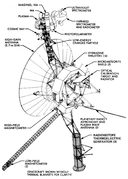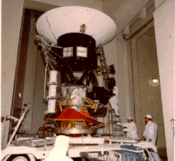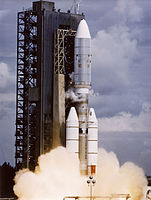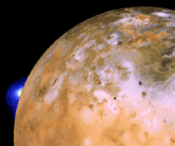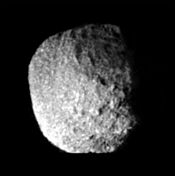- Voyager 2
-
For the phone sometimes referred to as the Voyager 2, see LG enV touch.
Voyager 2 
Voyager spacecraftOperator NASA / JPL Mission type Flyby Flyby of Jupiter, Saturn, Uranus, Neptune Launch date 1977-08-20 14:29:00 UTC
(34 years, 2 months and 22 days ago)Launch vehicle Titan IIIE / Centaur Launch site Space Launch Complex 41
Cape Canaveral Air Force StationMission duration In progress (Interstellar mission)
(32 years, 4 months and 2 days elapsed)
Jupiter flyby
(completed 1979-08-05)
Saturn flyby
(completed 1981-09-25)
Uranus flyby
(completed 1986-02-25)
Neptune flyby
(completed 1989-10-02)COSPAR ID 1977-076A Homepage NASA Voyager website Mass 721.9 kg (1,592 lb) Power 420 W (3 RTGs) References:
[1]The Voyager 2 spacecraft is a 722-kilogram (1,592 lb) space probe launched by NASA on August 20, 1977 to study the outer Solar System and eventually interstellar space. Operating for 34 years, 2 months and 22 days as of today (11 November 2011), the spacecraft receives routine commands and transmits data back to the Deep Space Network.
Part of the Voyager program with its identical sister craft Voyager 1, the spacecraft is currently in extended mission, tasked with locating and studying the boundaries of the Solar System, including the Kuiper belt, the heliosphere and interstellar space. The primary mission ended December 31, 1989 after encountering the Jovian system in 1979, Saturnian system in 1980, Uranian system in 1986, and the Neptunian system in 1989. It was the first probe to provide detailed images of the outer gas giants.
Contents
Mission background
History
Conceived in the 1960s, a Grand Tour proposal to study the outer planets, prompted NASA to begin work on a mission in the early 1970s. The development of the interplanetary probes coincided with an alignment of the planets, making possible a mission to the outer Solar System by taking advantage of the then-new technique of gravity assist.
It was determined that utilizing gravity assists would enable a single probe to visit the four gas giants (Jupiter, Saturn, Uranus, and Neptune) while requiring a minimal amount of propellant and a shorter transit duration between planets. Originally, Voyager 2 was planned as Mariner 12 of the Mariner program however, due to congressional budget cuts, the mission was scaled back to be a flyby of Jupiter and Saturn, and renamed the Mariner Jupiter-Saturn probes. As the program progressed, the name was later changed to Voyager as the probe designs began to differ greatly from previous Mariner missions.[2]
Upon a successful flyby of the Saturnian moon Titan, by Voyager 1, Voyager 2 would get a mission extension to send the probe on towards Uranus and Neptune.[3]
Golden record
Main article: Voyager Golden RecordEach Voyager space probe carries a gold-plated audio-visual disc in the event that either spacecraft is ever found by intelligent life-forms from other planetary systems. The discs carry photos of the Earth and its lifeforms, a range of scientific information, spoken greetings from the people (e.g. the Secretary-General of the United Nations and the President of the United States, and the children of the Planet Earth) and a medley, "Sounds of Earth", that includes the sounds of whales, a baby crying, waves breaking on a shore, and a variety of music.
Spacecraft design
Constructed by the Jet Propulsion Laboratory, Voyager 2 included 16 hydrazine thrusters, three-axis stabilization, gyroscopes and celestial referencing instruments (Sun sensor/Canopus Star Tracker) to maintain pointing of the high-gain antenna toward Earth. Collectively these instruments are part of the Attitude and Articulation Control Subsystem (AACS) along with redundant units of most instruments and 8 backup thrusters. The spacecraft also included 11 scientific instruments to study celestial objects as it traveled through space.[4]
Communications
Built with the intent for eventual interstellar travel, Voyager 2 included a large, 3.7-meter parabolic, high-gain antenna (see diagram) to transceive data with the Deep Space Network on Earth. Communications are conducted over the S-band (13 cm wavelength) and X-band (3.6 cm wavelength) providing bandwidth as high as 115.2 kilobits per second. When the spacecraft is unable to communicate with Earth, the Digital Tape Recorder (DTR) is able to record up to 62,500-kilobytes of data to later transmit when communication is reestablished.[4]
Power
The spacecraft was built with 3 Multihundred-Watt radioisotope thermoelectric generators (MHW RTG). Each RTG includes 24 pressed plutonium oxide spheres and provide enough heat to generate approximately 157 watts of power at launch. Collectively, the RTGs supply the spacecraft with 470 watts at launch and will allow operations to continue until at least 2020.[4][5][6] (see diagram 1, 2)
Scientific instruments
Expand Instrument Name Abr. Description Imaging Science System
(disabled)(ISS) Utilizes a two-camera system (narrow-angle/wide-angle) to provide imagery of Jupiter, Saturn and other objects along the trajectory. More Filters Narrow Angle Camera Filters[7] Name Wavelength Spectrum Sensitivity Clear 280 nm – 640 nm UV 280 nm – 370 nm Violet 350 nm – 450 nm Blue 430 nm – 530 nm ' ' ' Green 530 nm – 640 nm ' ' ' Orange 590 nm – 640 nm ' ' ' Wide Angle Camera Filters[8] Name Wavelength Spectrum Sensitivity Clear 280 nm – 640 nm ' ' ' Violet 350 nm – 450 nm Blue 430 nm – 530 nm CH4-U 536 nm – 546 nm Green 530 nm – 640 nm Na-D 588 nm – 590 nm Orange 590 nm – 640 nm CH4-JST 614 nm – 624 nm - Principal investigator: Bradford Smith / University of Arizona (PDS/PRN website)
- Data: PDS/PDI data catalog, PDS/PRN data catalog
Radio Science System
(disabled)(RSS) Utilized the telecommunications system of the Voyager spacecraft to determine the physical properties of planets and satellites (ionospheres, atmospheres, masses, gravity fields, densities) and the amount and size distribution of material in Saturn's rings and the ring dimensions. More - Principal investigator: G. Tyler / Stanford University PDS/PRN overview
- Data: PDS/PPI data catalog, PDS/PRN data catalog (VG_2803), NSSDC Saturn data archive
Infrared Interferometer Spectrometer
(disabled)(IRIS) Investigates both global and local energy balance and atmospheric composition. Vertical temperature profiles are also obtained from the planets and satellites as well as the composition, thermal properties, and size of particles in Saturn's rings. More - Principal investigator: Rudolf Hanel / NASA Goddard Space Flight Center (PDS/PRN website)
- Data: PDS/PRN data catalog, PDS/PRN expanded data catalog (VGIRIS_0001, VGIRIS_002)
Ultraviolet Spectrometer
(disabled)(UVS) Designed to measure atmospheric properties, and to measure radiation. More - Principal investigator: A. Broadfoot / University of Southern California (PDS/PRN website)
- Data: PDS/PRN data catalog
Triaxial Fluxgate Magnetometer
(active)(MAG) Designed to investigate the magnetic fields of Jupiter and Saturn, the solar-wind interaction with the magnetospheres of these planets, and the interplanetary magnetic field out to the solar wind boundary with the interstellar magnetic field and beyond, if crossed. More - Principal investigator: Norman Ness / NASA Goddard Space Flight Center (website)
- Data: PDS/PPI data catalog, NSSDC data archive
Plasma Spectrometer
(active)(PLS) Investigates the macroscopic properties of the plasma ions and measures electrons in the energy range from 5 eV to 1 keV. More - Principal investigator: John Richardson / MIT (website)
- Data: PDS/PPI data catalog, NSSDC data archive
Low Energy Charged Particle Instrument
(active)(LECP) Measures the differential in energy fluxes and angular distributions of ions, electrons and the differential in energy ion composition. More - Principal investigator: Stamatios Krimigis / JHU/APL / University of Maryland (JHU/APL website / UMD website / KU website)
- Data: UMD data plotting, PDS/PPI data catalog, NSSDC data archive
Cosmic Ray System
(active)(CRS) Determines the origin and acceleration process, life history, and dynamic contribution of interstellar cosmic rays, the nucleosynthesis of elements in cosmic-ray sources, the behavior of cosmic rays in the interplanetary medium, and the trapped planetary energetic-particle environment. More - Principal investigator: Edward Stone / CalTech / NASA Goddard Space Flight Center (website)
- Data: NSSDC data archive
Planetary Radio Astronomy Investigation
(disabled)(PRA) Utilizes a sweep-frequency radio receiver to study the radio-emission signals from Jupiter and Saturn. More Voyager: Sounds Of The Cosmos, the Album made from Voyager's PRA Instrument Recordings - Principal investigator: James Warwick / University of Colorado
- Data: PDS/PPI data catalog
Photopolarimeter System
(disabled)(PPS) Utilized a telescope with a polarizer to gather information on surface texture and composition of Jupiter and Saturn and information on atmospheric scattering properties and density for both planets. More - Principal investigator: Arthur Lane / JPL (PDS/PRN website)
- Data: PDS/PRN data catalog
Plasma Wave System
(partially disabled)(PWS) Provides continuous, sheath-independent measurements of the electron-density profiles at Jupiter and Saturn as well as basic information on local wave-particle interaction, useful in studying the magnetospheres. More - Principal investigator: Donald Gurnett / University of Iowa (website)
- Data: PDS/PPI data catalog
For more details on the Voyager space probes' identical instrument packages, see the separate article on the overall Voyager Program.
Images of the spacecraft Voyager spacecraft diagram.Voyager in transport to a solar thermal test chamber.Gold-Plated Record is attached to Voyager.Voyager 2 awaiting payload entry into a Titan/Centaur-6 rocket. Media related to the Voyager spacecraft at Wikimedia Commons
Media related to the Voyager spacecraft at Wikimedia CommonsMission profile
Timeline of travel Date Event 1977-08-20 Spacecraft launched at 14:29:00 UTC. 1977-12-10 Entered asteroid belt. 1977-12-19 Voyager 1 overtakes Voyager 2. (see diagram) 1978-06- Primary radio receiver fails. Remainder of mission flown using backup. 1978-10-21 Exited asteroid belt 1979-04-25 Start Jupiter observation phase Time Event 1979-07-08 Encounter with Jovian system. 12:21:00 Callisto flyby at 214,930 km. 1979-07-09 07:14:00 Ganymede flyby at 62,130 km. 17:53:00 Europa flyby at 205,720 km. 20:01:00 Amalthea flyby at 558,370 km. 22:29:00 Jupiter closest approach at 721,670 km from the center of mass. 23:17:00 Io flyby at 1,129,900 km. 1979-08-05 Phase Stop 1981-06-05 Start Saturn observation phase. Time Event 1981-08-22 Encounter with Saturnian system. 01:26:57 Iapetus flyby at 908,680 km. 1981-08-25 01:25:26 Hyperion flyby at 431,370 km. 09:37:46 Titan flyby at 666,190 km. 22:57:33 Helene flyby at 314,090 km. 1981-08-26 01:04:32 Dione flyby at 502,310 km. 02:22:17 Calypso flyby at 151,590 km. 02:24:26 Mimas flyby at 309,930 km. 03:19:18 Pandora flyby at 107,000 km. 03:24:05 Saturn closest approach at 161,000 km from the center of mass. 03:33:02 Atlas 287,000 km. 03:45:16 Enceladus flyby at 87,010 km. 03:50:04 Janus at 223,000 km. 04:05:56 Epimetheus at 147,000 km. 06:02:47 Telesto at 270,000 km. 06:12:30 Tethys flyby at 93,010 km. 06:28:48 Rhea flyby at 645,260 km. 1981-09-04 01:22:34 Phoebe flyby at 2,075,640 km. 1981-09-25 Phase Stop 1985-11-04 Start Uranus observation phase. Time Event 1986-01-24 Encounter with Uranian system. 16:50:00 Miranda flyby at 29,000 km. 17:25:00 Ariel flyby at 127,000 km. 17:25:00 Umbriel flyby at 325,000 km. 17:25:00 Titania flyby at 365,200 km. 17:25:00 Oberon flyby at 470,600 km. 17:59:47 Uranus closest approach at 107,000 km from the center of mass. 1986-02-25 Phase Stop 1989-06-05 Start Neptune observation phase. Time Event 1989-08-25 Encounter with Neptunian system. 03:56:36 Neptune closest approach at 29,240 km. 04:51:00 Larissa flyby at 60,180 km. 05:29:00 Proteus flyby at 97,860 km. 09:23:00 Triton flyby at 39,800 km. 1989-10-02 Phase Stop 1989-10-02 Begin Voyager Interstellar Mission. Intersteller phase[9][10][11] 1990-02-14 Final images of the Voyager Program acquired by Voyager 1 to create the Solar System "Family Portrait". 1997-08-20 20 years of continuous flight and operation at 14:29:00 UTC. 1998-11-13 Terminate scan platform and UV observations. 2007-08-20 30 years of continuous flight and operation at 14:29:00 UTC. 2007-09-06 Terminate data tape recorder operations. 2008-02-22 Terminate planetary radio astronomy experiment operations. 2011-11-07 Switch to backup thrusters to conserve power[12] Launch and trajectory
The Voyager 2 probe was launched on August 20, 1977, by the National Aeronautics and Space Administration from Space Launch Complex 41 at Cape Canaveral, Florida, aboard a Titan IIIE/Centaur launch vehicle. Two weeks later, the twin Voyager 1 probe would be launched on September 5, 1977. However, Voyager 1 would reach both Jupiter and Saturn sooner, as Voyager 2 had been launched into a longer, more circular trajectory.
-
Voyager 2 launch on August 20, 1977 with a Titan IIIE/Centaur.
-
Plot of Voyager 2's heliocentric velocity against its distance from the Sun, illustrating the use of gravity assist to accelerate the spacecraft by Jupiter, Saturn and Uranus. To observe Triton, Voyager 2 passed over Neptune's north pole resulting in an acceleration out of the plane of the ecliptic and reduced velocity away from the Sun.[13]
Encounter with Jupiter
Main article: Exploration of JupiterThe closest approach to Jupiter occurred on July 9, 1979. It came within 570,000 km (350,000 mi) of the planet's cloud tops.[14] It discovered a few rings around Jupiter, as well as volcanic activity on the moon Io.
The Great Red Spot was revealed as a complex storm moving in a counterclockwise direction. An array of other smaller storms and eddies were found throughout the banded clouds.
Discovery of active volcanism on Io was easily the greatest unexpected discovery at Jupiter. It was the first time active volcanoes had been seen on another body in the Solar System. Together, the Voyagers observed the eruption of nine volcanoes on Io, and there is evidence that other eruptions occurred between the two Voyager fly-bys.
The moon Europa displayed a large number of intersecting linear features in the low-resolution photos from Voyager 1. At first, scientists believed the features might be deep cracks, caused by crustal rifting or tectonic processes. The closer high-resolution photos from Voyager 2, however, left scientists puzzled: The features were so lacking in topographic relief that as one scientist described them, they "might have been painted on with a felt marker." Europa is internally active due to tidal heating at a level about one-tenth that of Io. Europa is thought to have a thin crust (less than 30 km (19 mi) thick) of water ice, possibly floating on a 50-kilometer-deep (30 mile) ocean.
Two new, small satellites, Adrastea and Metis, were found orbiting just outside the ring. A third new satellite, Thebe, was discovered between the orbits of Amalthea and Io.
The Great Red Spot photographed during the Voyager 2 flyby of Jupiter.A color mosaic of Europa.A color mosaic of Ganymede.Callisto photographed at a distance of 1 million kilometers.One faint ring of Jupiter photographed during the flyby.Atmospheric eruptive event on Jupiter. Media related to the Voyager 2 Jupiter encounter at Wikimedia Commons
Media related to the Voyager 2 Jupiter encounter at Wikimedia CommonsEncounter with Saturn
Main article: Exploration of SaturnThe closest approach to Saturn occurred on August 26, 1981.[15]
While passing behind Saturn (as viewed from Earth), Voyager 2 probed Saturn's upper atmosphere with its radio link to gather information on atmospheric temperature and density profiles. Voyager 2 found that at the uppermost pressure levels (seven kilopascals of pressure), Saturn's temperature was 70 kelvins (−203 °C), while at the deepest levels measured (120 kilopascals) the temperature increased to 143 K (−130 °C). The north pole was found to be 10 kelvins cooler, although this may be seasonal (see also Saturn Oppositions).
After the fly-by of Saturn, the camera platform of Voyager 2 locked up briefly, putting plans to officially extend the mission to Uranus and Neptune in jeopardy. Fortunately, the mission's engineers were able to fix the problem (caused by an overuse that temporarily depleted its lubricant), and the Voyager 2 probe was given the go-ahead to explore the Uranian system.
Voyager 2 Saturn approach view.North, polar region of Saturn imaged in orange and UV filters.Color image of Enceladus showing terrain of widely varying ages.Cratered surface of Tethys at 594,000 km.Atmosphere of Titan imaged from 2.3 million km.Two-toned Iapetus, August 22, 1981."Spoke" features observed in the rings of Saturn. Media related to the Voyager 2 Saturn encounter at Wikimedia Commons
Media related to the Voyager 2 Saturn encounter at Wikimedia CommonsEncounter with Uranus
Main article: Exploration of UranusThe closest approach to Uranus occurred on January 24, 1986, when Voyager 2 came within 81,500 kilometers (50,600 mi) of the planet's cloud tops. Voyager 2 also discovered the moons Cordelia, Ophelia, Bianca, Cressida, Desdemona, Juliet, Portia, Rosalind, Belinda, Perdita and Puck; studied the planet's unique atmosphere, caused by its axial tilt of 97.8°; and examined the Uranian ring system.
Uranus is the third largest (Neptune has a larger mass, but a smaller volume) planet in the Solar System. It orbits the Sun at a distance of about 2.8 billion kilometers (1.7 billion miles), and it completes one orbit every 84 years. The length of a day on Uranus as measured by Voyager 2 is 17 hours, 14 minutes. Uranus is unique among the planets in that its axial tilt is about 90°, meaning that its axis is roughly parallel, not perpendicular to the plane of the ecliptic. This extremely large tilt of its axis is thought to be the result of a collision between the accumulating planet Uranus with another planet-sized body early in the history of the Solar System. Given the unusual orientation of its axis, with the polar regions of Uranus exposed for periods of many years to either continuous sunlight or darkness, planetary scientists were not at all sure what to expect when observing Uranus.
Voyager 2 found that one of the most striking effects of the sideways orientation of Uranus is the effect on the tail of the planetary magnetic field. This is itself tilted about 60 degrees from the Uranian axis of rotation. The planet's magneto tail was shown to be twisted by the rotation of Uranus into a long corkscrew shape following the planet. The presence of a significant magnetic field for Uranus was not at all known until Voyager's 2 arrival.
The radiation belts of Uranus were found to be of an intensity similar to those of Saturn. The intensity of radiation within the Uranian belts is such that irradiation would "quickly" darken—within 100,000 years—any methane that is trapped in the icy surfaces of the inner moons and ring particles. This kind of darkening might have contributed to the darkened surfaces of the moons and the ring particles, which are almost uniformly dark gray in color.
A high layer of haze was detected around the sunlit pole of Uranus. This area was also found to radiate large amounts of ultraviolet light, a phenomenon that is called "dayglow." The average atmospheric temperature is about 60 K (−350 °F/−213 °C). Surprisingly, the illuminated and dark poles, and most of the planet, exhibit nearly the same temperatures at the cloud tops.
The Uranian moon Miranda, the innermost of the five large moons, was discovered to be one of the strangest bodies yet seen in the Solar System. Detailed images from Voyager 2's flyby of Miranda showed huge canyons made from geological faults as deep as 20 kilometers (12 mi), terraced layers, and a mixture of old and young surfaces. One hypothesis suggests that Miranda might consist of a reaggregation of material following an earlier event when Miranda was shattered into pieces by a violent impact.
All nine of the previously known Uranian rings were studied by the instruments of Voyager 2. These measurements showed that the Uranian rings are distinctly different from those at Jupiter and Saturn. The Uranian ring system might be relatively young, and it did not form at the same time that Uranus did. The particles that make up the rings might be the remnants of a moon that was broken up by either a high-velocity impact or torn up by tidal effects.
Uranus viewed from 18 million km.Departing image of crescent Uranus.Fractured surface of Miranda.Ariel as imaged from 130,000 km.Color composite of Titania from 500,000 km.Umbriel (moon) imaged from 550,000 km.Color composite of Oberon.The Rings of Uranus imaged by Voyager 2. Media related to the Voyager 2 Uranus encounter at Wikimedia Commons
Media related to the Voyager 2 Uranus encounter at Wikimedia CommonsEncounter with Neptune
Main article: Exploration of NeptuneVoyager 2's closest approach to Neptune occurred on August 25, 1989.[16][17] Since this was the last planet of our Solar System that Voyager 2 could visit, the Chief Project Scientist, his staff members, and the flight controllers decided to also perform a close fly-by of Triton, the larger of Neptune's two originally known moons, so as to gather as much information on Neptune and Triton as possible, regardless of what angle at which Voyager 2 would fly away from Neptune. This was just like the case of Voyager 1's encounters with Saturn and its massive moon Titan.
Through repeated computerized test simulations of trajectories through the Neptunian system conducted in advance, flight controllers determined the best way to route Voyager 2 through the Neptune-Triton system. Since the plane of the orbit of Triton is tilted significantly with respect to the plane of the ecliptic, through mid-course corrections, Voyager 2 was directed into a path several thousand miles over the north pole of Neptune. At that time, Triton was behind and below (south of) Neptune (at an angle of about 25 degrees below the Ecliptic), close to the apoapsis of its elliptical orbit. The gravitational pull of Neptune bent the trajectory of Voyager 2 down in the direction of Triton. In less than 24 hours, Voyager 2 traversed the distance between Neptune and Triton, and then observed the northern hemisphere of Triton as it passed over the moon's north pole.
The net and final effect on the trajectory of Voyager 2 was to bend its trajectory south below the plane of the Ecliptic by about 30 degrees. Voyager 2 is on this path permanently, and hence, it is exploring space south of the plane of the Ecliptic, measuring magnetic fields, charged particles, etc., there, and sending the measurements back to the Earth via telemetry.
While in the neighborhood of Neptune, Voyager 2 discovered the "Great Dark Spot", which has since disappeared, according to observations by the Hubble Space Telescope. Originally thought to be a large cloud itself, the "Great Dark Spot" was later hypothesized to be a hole in the visible cloud deck of Neptune.
Neptune's atmosphere consists of hydrogen, helium, and methane. The methane in Neptune's upper atmosphere absorbs the red light from the Sun, but it reflects the blue light from the Sun back into space. This is why Neptune looks blue.
For decades, beginning in the late 19th century, it was widely thought that an unseen planet (dubbed "Planet X") was influencing the orbits of Uranus and Neptune, by perturbing them, since their observed positions differed somewhat from the positions predicted by calculations. This notion might have brought about the 1930 discovery of Pluto, but the actual discovery of Pluto by Clyde Tombaugh in 1930 was an accidental one that occurred while a few astronomers were scanning areas of the sky for "Planet X".
The notion of a "Planet X" has persisted, because over the decades since 1930, it became increasingly clear that Pluto has insufficient mass to account for the observational discrepancies. When Voyager 2 flew-by Neptune, it took very precise measurements of Neptune's mass. Neptune was evaluated at about 0.5 percent less massive than previous estimates — a difference comparable to a planet with the mass of Mars. When the orbits of Uranus and Neptune orbits were recalculated using the more accurate mass figure, it was found that the imprecise number for Neptune — and not the gravity of an unseen planet — caused the orbital discrepancies that had long perplexed planetary astronomers.[18]
With the decision of the International Astronomical Union to reclassify Pluto as a "plutoid" in 2008, the flyby of Neptune by Voyager 2 in 1989 became the point when every known planet in the Solar System had been visited at least once by a space probe.
Voyager 2 image of Neptune.Despina as imaged from Voyager 2.Cratered surface of Larissa.Dark surface of Proteus.Color mosaic of Voyager 2 Triton.Cirrus clouds imaged above gaseous Neptune.Rings of Neptune taken in occultation from 280,000 km. Media related to the Voyager 2 Neptune encounter at Wikimedia Commons
Media related to the Voyager 2 Neptune encounter at Wikimedia CommonsInterstellar mission
Since its planetary mission is over, Voyager 2 is now described as working on an interstellar mission, which NASA is using to find out what the Solar System is like beyond the heliosphere. On August 30, 2007, Voyager 2 passed the termination shock into the heliosheath, approximately 1 billion miles (1.6 billion km) closer to the Sun than Voyager 1 did.[19] This is due to the local interstellar magnetic field of deep space. The southern hemisphere of the Solar System's heliosphere is being pushed in.[20]
As of April 13, 2010, Voyager 2 was at a distance of around 91.898 AU (13.747 billion km, 8.542 billion miles or 0.001443 light years) from the Sun, deep in the scattered disc, and traveling outward at roughly 3.264 AU per year. [21] It is more than twice as far from the Sun as Pluto, and far beyond the perihelion of 90377 Sedna, but not yet beyond the outer limits of the orbit of the dwarf planet Eris.
Voyager 2 is not headed toward any particular star. If left alone, it should pass by star Sirius, which is currently about 2.6 parsecs from the Sun[22][23] and moving diagonally towards the Sun, at a distance of 1.32 parsecs (4.3 ly, 25 trillion mi) in about 296,000 years.[24]
Voyager 2 is expected to keep transmitting weak radio messages until at least 2025, over 48 years since it was launched.[25]
Year End of specific capabilities as a result of the available electrical power limitations 1998 Terminate scan platform and UV observations 2007 Termination of Digital Tape Recorder (DTR) operations (It was no longer needed due to a failure on the High Waveform Receiver on the Plasma Wave Subsystem (PWS) on June 30, 2002.[26]) 2008 Power off Planetary Radio Astronomy Experiment (PRA) 2015 approx Termination of gyroscopic operations 2020 approx Initiate instrument power sharing 2025 or slightly afterwards Can no longer power any single instrument Current status
Voyager 2 is currently transmitting scientific data at about 160 bits per second. Information about continuing telemetry exchanges with Voyager 2 is available from Voyager Weekly Reports. Information on the current location of Voyager 2 can be found at HeavensAbove.
As of November 4, 2011, Voyager 2, traveling at 15.464 km/s, is about 97.1612 astronomical units (1.453511×1010 km) from the Earth and about 96.847545 astronomical units (1.44881865×1010 km) from the Sun,[27] at −55.01° declination and 19.905 h right ascension, and is also at an ecliptic latitude of −33.6 degrees, placing it in the constellation Telescopium as observed from Earth.[28]
On November 30, 2006, a telemetered command to Voyager 2 was incorrectly decoded by its on-board computer—in a random error—as a command to turn on the electrical heaters of the spacecraft's magnetometer. These heaters remained turned on until December 4, 2006, and during that time, there was a resulting high temperature above 130 °C (266 °F), significantly higher than the magnetometers were designed to endure, and a sensor rotated away from the correct orientation. It has not been possible to fully diagnose and correct for the damage caused to the Voyager 2's magnetometer, although efforts to do so are proceeding.[29]
On April 22, 2010, Voyager 2 encountered scientific data format problems as reported by the Associated Press on May 6, 2010.[30] On May 17, 2010, JPL engineers revealed that a flipped bit in an on-board computer had caused the issue, and scheduled a bit reset for May 19.[31] On May 23, 2010, Voyager 2 has resumed sending science data from deep space after engineers fixed the flipped bit.[32] Currently research is being made into making the area of memory with the flipped bit off limits or disallowing its use.
The Low-Energy Charged Particle Instrument is currently operational and data from this instrument concerning charged particles is being transmitted to Earth. This data permits measurements of the heliosheath and termination shock. There has also been a modification to the on-board flight software to delay turning off the AP Branch 2 backup heater for 1 year. It was scheduled to go off February 2, 2011 (DOY 033, 2011–033).
There are regular posts of the current distance of Voyager 2 to Earth in light-travel time to Twitter.[33]
See also
- Pioneer 10
- Pioneer 11
- Voyager 1
- Voyager: Sounds of the Cosmos, the album made from Voyager's recordings
- Voyager Golden Record
- Voyager program for more information about this spacecraft
References
- ^ "VOYAGER:Mission Information". NASA. 1989. http://starbrite.jpl.nasa.gov/pds/viewMissionProfile.jsp?MISSION_NAME=VOYAGER. Retrieved January 2, 2011.
- ^ Planetary Voyage NASA Jet Propulsion Laboratory – California Institute of Technology. March 23, 2004. Retrieved April 8, 2007.
- ^ Chapter 11 "Voyager: The Grand Tour of Big Science" (sec. 268.), by Andrew,J. Butrica, found in From Engineering Science To Big Science ISBN 978-0160496400 edited by Pamela E. Mack, NASA, 1998
- ^ a b c "VOYAGER 2:Host Information". NASA. 1989. http://starbrite.jpl.nasa.gov/pds/viewHostProfile.jsp?INSTRUMENT_HOST_ID=VG2. Retrieved January 2, 2011.
- ^ "Voyager 2 Craft Details". NASA-NSSDC-Spacecraft-Details. NASA. http://nssdc.gsfc.nasa.gov/nmc/spacecraftDisplay.do?id=1977-076A. Retrieved March 9, 2011.
- ^ Furlong, Richard R.; Wahlquist, Earl J. (1999). "U.S. space missions using radioisotope power systems". Nuclear News 42 (4): 26–34. http://www2.ans.org/pubs/magazines/nn/pdfs/1999-4-2.pdf. Retrieved January 2, 2011.
- ^ "Voyager 1 Narrow Angle Camera Description". NASA / PDS. August 26, 2003. http://pds-rings.seti.org/voyager/iss/inst_cat_na2.html#filters. Retrieved January 17, 2011.
- ^ "Voyager 1 Wide Angle Camera Description". NASA / PDS. August 26, 2003. http://pds-rings.seti.org/voyager/iss/inst_cat_wa2.html#filters. Retrieved January 17, 2011.
- ^ "Voyager 2 Full Mission Timeline" Muller, Daniel, 2010
- ^ "Voyager Mission Description" NASA, February 19, 1997
- ^ "JPL Mission Information" NASA, JPL, PDS.
- ^ http://www.jpl.nasa.gov/news/news.cfm?release=2011-341&rn=news.xml&rst=3189
- ^ Basics of space flight: Interplanetary Trajectories
- ^ "Voyager 2, July 9, 1979"
- ^ Nasa
- ^ "Voyager – Fact Sheet". http://voyager.jpl.nasa.gov/news/factsheet.html. Retrieved August 28, 2009. "Following Voyager 2's closest approach to Neptune on August 25, 1989"
- ^ Nardo 2002, p. 15
- ^ Croswell, Ken, Planet Quest: The Epic Discovery of Alien Solar Systems (1997), pg. 66
- ^ Voyager 2 Proves Solar System Is Squashed NASA.gov #2007-12-10
- ^ Voyager 2 finds solar system's shape is 'dented' # 2007-12-10, Week Ending December 14, 2007. Retrieved Dec 12, 2007.
- ^ Voyager Mission Operations Status Report # 2009-06-26, Week Ending June 26, 2009.. Retrieved August 21, 2009.
- ^ Henry, Dr. Todd J. (July 1, 2006). "The One Hundred Nearest Star Systems". Georgia State University. http://www.chara.gsu.edu/RECONS/TOP100.posted.htm. Retrieved November 27, 2008.
- ^ Distance in light years derived from 3.26/measured parallax of 0.38002 arcseconds as of January 1, 2008
- ^ "Voyager – Mission – Interstellar Mission". NASA. June 22, 2007. http://voyager.jpl.nasa.gov/mission/interstellar.html. Retrieved November 27, 2008.
- ^ "Voyager – Spacecraft – Spacecraft Lifetime". NASA Jet Propulsion Laboratory. March 15, 2008. http://voyager.jpl.nasa.gov/spacecraft/spacecraftlife.html. Retrieved May 25, 2008.
- ^ "Voyager – Interstellar Science". NASA Jet Propulsion Laboratory. December 1, 2009. http://voyager.jpl.nasa.gov/science/index.html. Retrieved December 2, 2009.
- ^ "Where are the Voyagers?". NASA. http://voyager.jpl.nasa.gov/where/index.html. Retrieved November 04, 2011.
- ^ Peat, Chris. "Spacecraft escaping the Solar System". Heavens Above. http://www.heavens-above.com/solar-escape.asp. Retrieved May 23, 2010.
- ^ Notes on Voyager 2 Quick Look Data: Data after November 29, 2006
- ^ John Antczak (May 6, 2010). "NASA working on Voyager 2 data problem". Associated Press. http://www.boston.com/news/nation/articles/2010/05/06/nasa_working_on_voyager_2_data_problem/.
- ^ "Engineers Diagnosing Voyager 2 Data System". Jet Propulsion Laboratory. http://www.jpl.nasa.gov/news/news.cfm?release=2010-151. Retrieved May 17, 2010.
- ^ "NASA Fixes Bug On Voyager 2". http://www.space-travel.com/reports/NASA_Fixes_Bug_On_Voyager_2_999.html. Retrieved May 25, 2010.
- ^ NASAVoyager2 Twitter feed
Further reading
- "Saturn Science Results". Voyager Science Results at Saturn. http://voyager.jpl.nasa.gov/science/saturn.html. Retrieved February 8, 2005.
- "Uranus Science Results". Voyager Science Results at Uranus. http://voyager.jpl.nasa.gov/science/uranus.html. Retrieved February 8, 2005.
- Nardo, Don (2002). Neptune. Thomson Gale. ISBN 0737710012
- JPL Voyager Telecom Manual
External links
 Media related to Voyager 2 at Wikimedia Commons
Media related to Voyager 2 at Wikimedia Commons- NASA Voyager website
- Voyager Spacecraft Lifetime
- Voyager 2 Mission Profile by NASA's Solar System Exploration
- Voyager 2 (NSSDC Master Catalog)
- Spacecraft Escaping the Solar System – current positions and diagrams
- Mission state
- Voyager Recent 6-hour History dead link
- Voyager 2 Detects Odd Shape of Solar System's Edge May 23, 2006
- Voyager 2 software faults at launch, 1977 Aug 20 10:29
- Voyager 2 Twitter
Spacecraft missions to Jupiter Flybys 
Orbiters Descent probes Future missions - Europa Jupiter System Mission (2020)
- Io Volcano Observer
Canceled missions - Pioneer H
- Tsiolkovsky mission
- Europa Orbiter
- Jovian Europa Orbiter
- Jupiter Icy Moons Orbiter
Related topics - Deep Space Network
- Portal:Robotics
- Exploration of Io
Bold italics indicates active missions Spacecraft missions to Saturn Flybys - Pioneer 11
- Voyager 1
- Voyager 2

Orbiters Future missions - Titan Saturn System Mission (after 2020)
Proposed missions - Kronos (after 2015)
- Titan Mare Explorer (after 2016)
Canceled missions - Saturn mission
- Titan and Enceladus Mission
- Titan Explorer
Bold italics indicates active missions Uranus Discovery 
Characteristics - Atmosphere
- Climate (Uranus Dark Spot)
- Magnetosphere
- Rings
- Moons
Major moons Exploration - Voyager program (Voyager 2)
- Uranus orbiter and probe (proposed)
Miscellaneous - 15 Orionis
- Uranus-crossing minor planets
- Uranus in fiction
Neptune Discovery 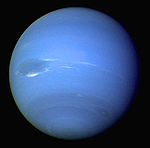
Characteristics - Rings
- Great Dark Spot
- Small Dark Spot
- The Scooter
- Kuiper belt
Moons Exploration - Voyager 2
- Mariner Mark II
- Neptune Orbiter
Trojans Miscellaneous Science instruments on satellites and spacecraft Radio science
(planetary
occultation)Cassini–Huygens · Mariner 2 · Mariner 3 · Mariner 4 · Mariner 5 · Mariner 6 and 7 · Mariner 9 · Mariner 10 · Voyager 1 · Voyager 2 · MESSENGER · Venus Express · Mars ExpressRadiometer Near Earth satelliteInfrared (IR)Near Earth satelliteInterplanetaryUltraviolet (UV) ·Near Earth satelliteSpectro-
photometersLong wavelengthInterplanetaryNear Earth satelliteInterplanetaryInterplanetaryMagnetometer Near Earth satelliteInterplanetaryVoyager 1 · Voyager 2InterplanetaryMariner 2 · Mariner 4 · Mariner 5 · Mariner 10 · Cassini–Huygens · Venus Express · MESSENGER · MagsatHelium vapor1, 2InterplanetaryParticle
detectorsIon detectorsNear EarthInterplanetaryNeutral particle detectorInterplanetaryCategories:- Radio frequency propagation
- Voyager program
- Jupiter spacecraft
- Saturn spacecraft
- Uranus spacecraft
- Neptune spacecraft
- Active extraterrestrial probes
- Spacecraft escaping the Solar System
- 1977 in spaceflight
- 1977 in the United States
- 1977 robots
- Nuclear-powered robots
Wikimedia Foundation. 2010.



